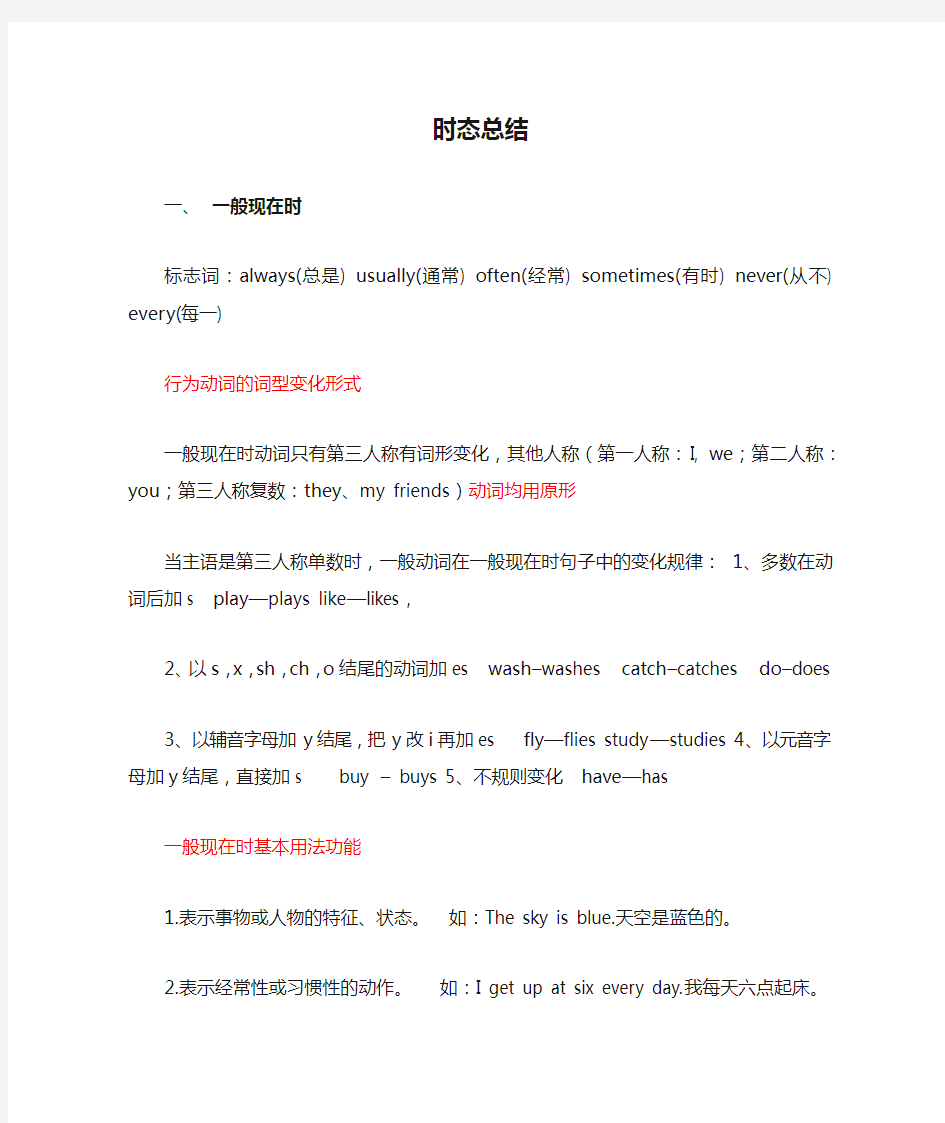小学六年级英语 时态总结


时态总结
一、一般现在时
标志词:always(总是) usually(通常) often(经常) sometimes(有时) never(从不) every(每一)
行为动词的词型变化形式
一般现在时动词只有第三人称有词形变化,其他人称(第一人称:I, we;第二人称:you;第三人称复数:they、my friends)动词均用原形
当主语是第三人称单数时,一般动词在一般现在时句子中的变化规律:
1、多数在动词后加s play—plays like—likes ,
2、以s,x,sh,ch,o结尾的动词加es wash–washes catch–catches do–does
3、以辅音字母加y结尾,把y改i再加es fly—flies study—studies
4、以元音字母加y结尾,直接加s buy –buys
5、不规则变化have—has
一般现在时基本用法功能
1.表示事物或人物的特征、状态。如:The sky is blue.天空是蓝色的。
2.表示经常性或习惯性的动作。如:I get up at six every day.我每天六点起床。
3.表示客观现实。如:The earth goes around the sun.地球绕着太阳转。构成
1. be动词:主语+be(am,is,are)+其它。
如:I am a boy.我是一个男孩。
2.行为动词:主语+行为动词(+其它)。
如:We study English.我们学习英语。
句型
肯定句:
①be动词:主语+ be + 其它成分He is a worker.
②行为动词:主语+动词(注意人称变化) +其它成分We like the little cat.
否定句:
①be动词:主语+ be + not +其它成分They are not students.
②行为动词:主语+助动词(do/does) + not +动词原形+其它成分
We don’t like the cat.
一般疑问句:
①be动词:Am / Is /Are +主语+ 其它成分
Are you a teacher? Yes, I am. / No, I am not.
Are they students of your school? Yes they are / No they aren’t.
②行为动词:助动词(Do/Does)+主语+动词原形+ 其它成分
Do you like it? Yes, I do. / No. I don’t.
Does he(she) like it? Yes, he (she) does. / No, he (she)doesn’t.
特殊疑问句:
疑问词+ 一般疑问句
①be动词:How many students are there in your school?
②行为动词:What do you usually do on Sunday?
一般现在时动词be和have的变化形式
1.动词Be叫连系动词, 用法:第一人称单数用am,第三人称单数用is,其它人称用are。
2.动词have的用法:第三人称单数用has以外,其它人称一律用have。(注意事项当have如果不表示“有”时,构成疑问或否定句时,就借助于助动词do, does)
如:I have lunch at 12 o’clock. 否定式:I don’t have lunch at 12 o’clock. (表示吃)
二、现在进行时
标志词:now, look, listen,It’s+时间.
现在进行时: 表示正在进行的、发生的动作
基本结构:am, is, are+ 动词ing
肯定句:主语+ be动词(am, are, is)+ 现在分词(ing)+ 其他
I am watching TV.
否定句:主语+ be动词+ not + 现在分词(ing)+ 其他
I am not watching TV.
一般疑问句:Be动词(Am, Are, Is) + 主语+ 现在分词(ing)+ 其他Are you watching TV? Yes, I am. / No, I am not.
特殊疑问句:疑问词+ 一般疑问句
What are you doing?
动词的-ing形式的变化规律:
1. 直接加-ing watch—watching clean—cleaning
2. 以-y结尾的动词,直接加-ing study—studying play—playing
3. 以不发音的-e结尾的动词,先去-e再加-ingmake—making
4. 末尾只有一个元音字母和一个辅音字母的重读闭音节动词,双写末尾字母,再加-ing cut—cutting swimming
三、一般将来时的用法:
表示将来某一时刻的动作或状态,或将来某一段时间内经常的动作或状态。
标志词:tomorrow(明天),the day after tomorrow(后天),next (下一个),from now on(从现在开始),in the future(将来),soon(不久)等
结构:
( 1 ) be(am, is,are)+going to+动词原形
( 2 ) will+动词原形“be going to+动词原形(打算…)”=”will+动词原形(将,会…)
(3)I’m going to study tomorrow. I will study tomorrow.
(be going to着重于事先考虑好、主观的想法,will 未事先考虑好)一般不用考虑
肯定句:①主语+ be (am, are, is) going to + 动词原形. ②主语+ will + 动词原形
否定句:①主语+ be (am, are, is) not going to + 动词原形. ②主语+ won’t + 动词原形.
一般疑问句:Be (Am, Are, Is) + 主语+ going to + 动词原形?
Will + 主语+ 动词原形?
特殊疑问句:疑问词+ 一般疑问句?
(注意:will 常简略为'll,并与主语连写在一起,如:I'll,he'll,it'll,we'll,you'll,they'll。)
四、一般过去时
标志词:yesterday(昨天), last (上一个), this morning(今天早上),ago(以前),before (在…之前), in 2002(在2002年)等
用法:表示过去某个时间发生的动作或存在的状态,常和表示过去的时间状语连用。也表示过去经常或反复发生的动作
动词过去式的变化规则:
1.一般在动词末尾加-ed如:watch-watched, cook-cooked
2.结尾是e加-d如:taste-tasted
3.末尾只有一个元音字母和一个辅音字母的重读闭音节,应双写末
尾的辅音字母,再加-ed,如:stop-stopped
4.以“辅音字母+y”结尾的,变y为i,再加-ed,如:study-studied
5.不规则动词过去式:am/is-was, are-were, do-did, see-saw, say-said,
give-gave…
句型:
1.Be动词在一般过去时中的变化:
⑴am 和is 变为was否定(was not=wasn’t)
⑵⑵are 变为were否定(were not=weren’t)
否定句:在was或were后加not
一般疑问句:把was或were调到句首。
2.行为动词在一般过去时中的变化
否定句:didn’t + 动词原形如:Jim didn’t go home yesterday.
一般疑问句:在句首加Did,句子中的动词过去式变回原形如:Did Jim go home yesterday?
特殊疑问句:
(1)疑问词+did+主语+动词原形?如: What did Jim do yesterday? (2)疑问词当主语时:疑问词+动词过去式?如:Who went to school yesterday?
